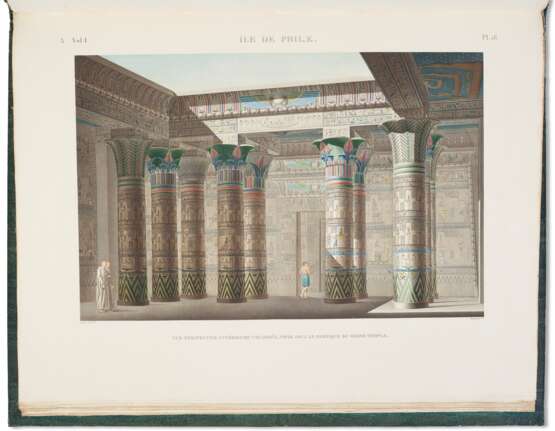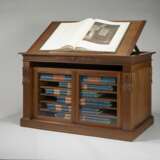ID 627541
Los 51 | Description de l'Egypte
Schätzwert
$ 300 000 – 500 000
First edition, issue with many colored plates, of the magnificent Napoleonic report on Egypt in blue publisher’s boards, the beginning of modern Egyptology, and the most significant publication ever produced by the French government. A truly monumental feat, comprising 18 volumes bound in 23, including three grand monde folios of plates; all housed in a custom reproduction cabinet. The contents are arranged into three categories: Antiquités, L'État moderne, and Histoire Naturelle, with text and plates bound separately. Publication took place over several decades, with livraisons released not necessarily in the order they are bound; copies with differing plate counts exist; this one matches the copy described by Blackmer except for three plates not included. The set is so large, both in number and in size, that Edouard Jomard designed a cabinet-cum-bookstand complete with Egyptian flourishes; a reproduction of that cabinet is included with this lot.
"Thirty years of collective effort went into the publication of this work, as well as untold suffering and privation in Egypt" (Blackmer). Napoleon later described his legendary Egyptian campaign in rosy terms as "the most beautiful time in my life," imagining himself "founding a religion, marching into Asia, riding an elephant, a turban on my head in my hand the new Koran I would have composed to suit my needs." Although it ultimately set Napoleon on the path to Emperor, it was not a military success. As J. Christopher Herold writes in the preface to his famous chronicle of the campaign, "the truth does not reflect very favorably on either Napoleon Bonaparte or the French soldiers and civilians who took part in his Egyptian campaign." But the campaign had other goals as well; when the French fleet led by L'Orient set sail for Alexandria, it carried not only soldiers but a research division, comprising civil engineers, cartographers, artists, mathematicians, chemists, zoologists, and more. Once in Egypt they formed the Institute of Egypt, divided into four areas: mathematics, physics, political economy, and the arts, which devoted itself to the study of every aspect of Egypt for the next three years. "Never before or since has a study of such scope and thoroughness been accomplished on the basis of field-work carried out in so short a space of time and under such inadequate and harrowing circumstances" (Herold).
As early as October 1798, the mathematician Jean-Baptiste Joseph Fourier, secretary of the Institute, was entrusted with the task of uniting the reports of various disciplines with a view to publication. The huge volume of information to be published meant adopting an apparently haphazard modus operandi: when sufficient plates or text on a particular subject were ready, they were published. Started under Napoleon's regime in 1809, there was a hiatus from 1813 until 1817 when the new Bourbon king, realizing the importance of the work, placed it above politics by supporting its completion. This was finally achieved in 1830.
"The Egyptologists of the 19th-century owed their knowledge of ancient Egypt to the efforts of the engineers who described the monuments of antiquity, and it was in the plates of the Description that these were revealed" (Blackmer). It was the largest printed work so far produced, one that "exhibits the sites of Egypt with detail augmented by each passing page, thus creating a much different viewing experience [than other contemporary view books] premised on an empirical, scientific unfolding. Beginning with an aerial map of a particular archaeological site, it then moves to a general view of the monuments in situ, followed by architectural elevation and plans, and intricate displays of any individual artifacts and inscriptions discovered" (Oliver).
Yet for all that this publication set the stage for European work on Egypt for the next two centuries, "there has been relatively little research devoted to it, particularly involving a critical analysis of its engravings" (Oliver). Its monumentality and historical significance as a publication has overshadowed a detailed study of its contents as it actually relates to Egypt. It is in many ways a younger sibling of Diderot's great Encyclopédie, isolating areas of knowledge for practical use and consumption. It presents Egypt not as it was, but as an object for French colonial consumption, often dramatizing the sense of decay and ruin in order to emphasize the gulf between the Antiquités and L'État moderne. Edward Said writes that it was part of the effort to "restore a region from its present barbarism to its former classical greatness; to instruct (for its own benefit) the Orient in the ways of the modern West; to subordinate or underplay military power in order to aggrandize the project of glorious knowledge acquired in the process of political domination of the Orient."
And it worked, too. While the Napoleonic Egyptian campaign was an utter failure, with less than half the original troops returning home alive and the definitive loss of French influence in the region, this publication represents the French victory in Egypt. A monumentally influential work which "gave" Egypt to the French in a more lasting way than military campaigns ever could, it is one of the most enduring remains of Napoleon's failed but legendary exploits in the arena of empire.
Blackmer 476; BAL RIBA 846; Brunet II, 616-617; Nissen BBI 2234; Nissen ZBI 4608. See also Baring, A Bibliographical Account and Collation of La Description de l'Egypte (1839); J. Christopher Herold, Bonaparte in Egypt (1963), and Liza Oliver, "Blindness Materialized: Disease, Decay, and Restoration in the Napoleon Description de l'Egypte (1809-1828)" in Seeing Across Cultures in the Early Modern World (2012).
PLATES: Ten volumes bound in fourteen, eleven of which large folio (706 x 530mm) and three grand monde (1075 x 703mm). 887 plates, some folding or in color (lacking two listed in Blackmer, nos. 45 and 29b; a little spotting and toning to plates and text, colored natural history plates especially toned; some volumes with a little worming in the gutter, title pages a little chipped or soiled in a few volumes).
TEXT: Eight volumes bound in nine (400 x 253mm). 30 plates, some folding, 4 engraved portraits, 10 tables (lacking one plate present in the Blackmer copy; a little spotting and toning to some plates, one map with repair to margin).
For details on a typical distribution of plates across the volumes, organized by subject matter, please see following lot.
All bound in contemporary blue marbled boards, with morocco title pieces (a little sunning, some wear and small repairs to caps of some volumes); with modern reproduction cabinet after Jomard.
| Künstler: | William Shakespeare (1564 - 1616) |
|---|---|
| Angewandte Technik: | Bleistift |
| Künstler: | William Shakespeare (1564 - 1616) |
|---|---|
| Angewandte Technik: | Bleistift |
| Adresse der Versteigerung |
CHRISTIE'S 8 King Street, St. James's SW1Y 6QT London Vereinigtes Königreich | |
|---|---|---|
| Vorschau |
| |
| Telefon | +44 (0)20 7839 9060 | |
| Aufgeld | see on Website | |
| Nutzungsbedingungen | Nutzungsbedingungen |

















